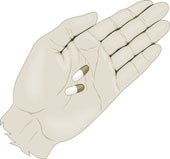 |
| PROBLEM CONCENTRATING? The ADHD child typically has too much “theta” brain wave activity. |
In a South London clinic, a young girl is sitting with an electrode attached to her scalp, staring intently at a computer screen. Ever so often there is a ping and on the screen, which shows a simple graphic of sea and sky; another bird appears, hovering above the water. That’s a signal that in the game Lara Hargrave, 10, is playing, using only her brain waves to control the action, she has just scored a point.
No, this isn’t some new teenage computer craze. It’s a high-tech brain therapy called neurofeedback that Lara’s mother Juliet claims has significantly alleviated her daughter’s attention deficit hyperactivity disorder (ADHD). Practitioners claim the therapy, which centres on the idea that the electrical activity in our brains can be trained to become healthier, has achieved dramatic results on attention disorders, depression, epilepsy, even incontinence.
Juliet Hargrave believes her daughter is proof of the treatment’s potential. “Lara’s teachers were constantly telling us: ‘She’s a bright girl; if only she could concentrate.’ When her school suggested ADHD in 2003, I was determined to avoid Ritalin, a stimulant commonly used to treat ADHD.” Online research led Hargrave to the Learning with Neurofeedback clinic in Wandsworth, South London, run by Melissa Foks, a member of the British Psychological Society. “Neurons in the brain communicate via electrical signals, called brain waves,” says Foks. “If you’re restfully gazing at the clouds, there will be a certain brain wave pattern; a lot of alpha brain-wave activity. If you’re deep in a maths problem, there will be a lot of beta.”
Put simply, the ADHD child typically has too much theta brain-wave activity — the kind associated with daydreaming — and not enough beta. Neurofeedback aims to alleviate the condition by raising beta activity and lessening theta, so a more normal brain wave profile is achieved.
During each 30-minute session, Lara’s brain waves are read by an electrode on her scalp, and fed to a desktop computer. Meanwhile, the game on the computer screen is set up to reward Lara whenever she produces the desired kind of brain waves. Lara will know she’s getting it right when she sees another bird appear in the sky, and the more often a new bird appears, the better she is doing.
Over many hours of therapy — so runs the theory — her brain will respond to this visible system of reward and learn how to produce “concentration” brain waves when she wants it to. And, crucially, she will take that ability away with her.
According to Dr Soren Andersen, a psychologist and neurofeedback researcher at the University of Swansea, “Neurofeedback is a tool that allows the brain to learn how to change at a fundamental level. Learning is slow: it typically takes 20 to 40 sessions to see a satisfactory result. On the upside, this is a non-invasive, non-pharmacological treatment.”
There is good evidence for efficacy on ADHD and epilepsy, claims Dr Andersen. “This is potentially a great tool, but there is a way to go,” he says.
Still, patients with mood disorders already talk of success with neurofeedback. In 2004 Jayne Forbes, 44, a mother of two from Hertfordshire, visited the EEG Neurofeedback Clinic in St Albans, run by Dr Surinder Kaur.
Dr Kaur has offered the treatment for 11 years and takes about five NHS referrals from GPs every year. Forbes’s complaint was depression. At the clinic, Forbes played a variety of neurofeedback games, including one where she had to keep a Pacman-type character moving through a maze. “At first, it seemed that I had no control over the game.
Then, gradually, I learnt that it was about clearing my mind completely and focusing on the screen. As I became better at keeping focused, it was a strange feeling. It made my brain feel huge; just this very expansive, calm, pleasant feeling.”
After 40 sessions, Forbes showed a significant change in brain wave profile. “If I felt myself becoming stressed, I could summon that calm feeling. I think that neurofeedback saved me having to take antidepressants.”
Now proponents say that neurofeedback has benefits for healthy subjects. In 2003, Professor John Gruzelier led an Imperial College study in which 97 students at the Royal College of Music were found to have significantly improved instrumental technique after a course of neurofeedback.
As for Lara, she says she is able to concentrate better. “Maths used to be her worst subject; she just scored 95 per cent in a test. I’m convinced that neurofeedback made the difference,” says Juliet.










